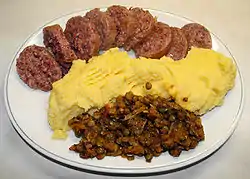Polenta
Polenta (/pəˈlɛntə, poʊˈ-/, Italian: [poˈlɛnta])[2][3] is a dish of boiled cornmeal that was historically made from other grains. The dish comes from Italy. It may be served as a hot porridge, or it may be allowed to cool and solidify into a loaf that can be baked, fried, or grilled.
 Polenta porridge with lentils (bottom) and cotechino sausage (top) | |
| Type | Porridge |
|---|---|
| Place of origin | Northern and Central Italy[1] |
| Main ingredients | Yellow or white cornmeal, liquid (water, soup stock) |

The variety of cereal used is usually yellow maize, but often buckwheat, white maize, or mixtures thereof may be used. Coarse grinds make a firm, coarse polenta; finer grinds make a soft, creamy polenta.[4] Polenta is a staple of Northern Italian, Swiss and Balkan (where it is called kačamak or žganci) cuisines (and, to a lesser extent, the Central Italian one, e.g. Tuscany)[1] and its consumption was traditionally associated with lower classes, as in times past cornmeal mush was an essential food in their everyday nutrition.[5]


Etymology
Latin: polenta covered any hulled and crushed grain, especially barley-meal, and is derived from the Latin: pollen for 'fine flour', which shares a root with pulvis, meaning 'dust'.[6]
History
As it is known today, polenta derives from earlier forms of grain mush (known as puls or pulmentum in Latin) that were commonly eaten since Roman times. Before the introduction of corn (maize) from America in the 16th century,[7] polenta was made from starchy ingredients like farro, chestnut flour, millet, spelt, and chickpeas.[8]
Cooking time
Polenta takes a long time to cook, simmering in four to five times its volume of watery liquid for about 45 minutes with near-constant stirring; this is necessary for even gelatinization of the starch. Some alternative cooking techniques have been invented to speed up the process, or to not require constant supervision. Quick-cooking (pre-cooked, instant) polenta is widely used and is prepared in just a few minutes; it is considered inferior to polenta made from unprocessed cornmeal and is best eaten after being baked or fried.[4]
In his book Heat, Bill Buford talks about his experiences as a line cook in Mario Batali's Italian restaurant Babbo. Buford details the differences in taste between instant polenta and slow-cooked polenta, and describes a method of preparation that takes up to three hours, but does not require constant stirring: "polenta, for most of its cooking, is left unattended. ... If you don't have to stir it all the time, you can cook it for hours—what does it matter, as long as you're nearby?"[9] Cook's Illustrated magazine has described a method using a microwave oven that reduces cooking time to 12 minutes and requires only a single stirring. In March 2010, it presented a stovetop, near-stir-less method that uses a pinch of baking soda (an alkali), which replicates the traditional effect.[10][11][12] Kyle Phillips suggested making it in a polenta maker or slow cooker.[13]
In culture

See also
- Ga'at
- Grits
- Farina (food)
- Hasty pudding
- List of maize dishes
- List of porridges
- Mămăligă
- Masa
- Tamales
- Pastel de choclo
- Mush
- Nshima
- Pap
- Pudding corn
- Sadza
- Ugali
- Upma
- Žganci
- Kačamak
References
- Righi Parenti, Giovanni (2003) [1995]. "Pisa, Lucca, Livorno". La cucina toscana [Tuscan cuisine] (in Italian). Rome: Newton & Compton. p. 384. ISBN 88-541-0141-9.
- Migliorini, Bruno; Tagliavini, Carlo; Fiorelli, Piero. Tommaso Francesco Borri (ed.). "Dizionario italiano multimediale e multilingue d'ortografia e di pronunzia". dizionario.rai.it. Rai Eri. Retrieved 12 February 2016.
- Canepari, Luciano. "Dizionario di pronuncia italiana online". dipionline.it. Retrieved 12 February 2016.
- "Polenta – How to Cook Polenta". mangiabenepasta.com. Retrieved 28 September 2015.
- "La storia della polenta" [The history of polenta]. I primi d'Italia (in Italian). Archived from the original on 2 December 2013. Retrieved 31 January 2016.
- Oxford English Dictionary 3rd edition, 2006, s.v.
- Dubreuil, P.; et al. (2006). "More on the Introduction of Temperate Maize into Europe: Large-Scale Bulk SSR Genotyping and New Historical Elements" (PDF). Maydica. 51: 281–291.
- Zeldes, Leah A. (3 November 2010). "Eat this! Polenta, a universal peasant food". Dining Chicago. Chicago's Restaurant & Entertainment Guide, Inc. Retrieved 18 May 2011.
- Buford, Bill (2006). Heat. New York: Alfred A. Knopf. p. 150. ISBN 1-4000-4120-1.
- Kimball, Christopher; Yanagihara, Dawn (January 1998). "The Microwave Chronicles". Cook's Illustrated: 11.
- Kimball, Christopher (March 2010). "Creamy Parmesan Polenta". Cook's Illustrated.
- "CI creamy polenta". Chowhound. 10 February 2010. Retrieved 28 September 2015.
- Kyle Phillips. "Polenta: Making it at Home". Retrieved 28 January 2007.
Further reading
- Brandolini, Giorgio V., Storia e gastronomia del mais e della patata nella Bergamasca, Orizzonte Terra, Bergamo, 2007. 32 pages.
- Eynard, W., La Cucina Valdese, Claudiana, 2006.